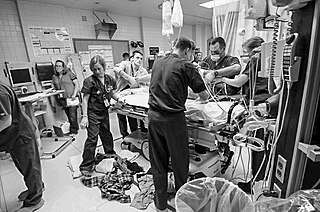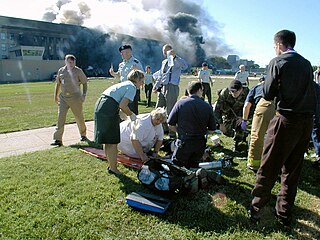The International Classification of Diseases (ICD) is a globally used medical classification used in epidemiology, health management and for clinical purposes. The ICD is maintained by the World Health Organization (WHO), which is the directing and coordinating authority for health within the United Nations System. The ICD is originally designed as a health care classification system, providing a system of diagnostic codes for classifying diseases, including nuanced classifications of a wide variety of signs, symptoms, abnormal findings, complaints, social circumstances, and external causes of injury or disease. This system is designed to map health conditions to corresponding generic categories together with specific variations, assigning for these a designated code, up to six characters long. Thus, major categories are designed to include a set of similar diseases.
Medical psychology or medico-psychology is the application of psychological principles to the practice of medicine, primarily drug-oriented, for both physical and mental disorders.

Emergency medicine is the medical speciality concerned with the care of illnesses or injuries requiring immediate medical attention. Emergency physicians specialize in providing care for unscheduled and undifferentiated patients of all ages. As first-line providers, in coordination with emergency medical services, they are primarily responsible for initiating resuscitation and stabilization and performing the initial investigations and interventions necessary to diagnose and treat illnesses or injuries in the acute phase. Emergency medical physicians generally practice in hospital emergency departments, pre-hospital settings via emergency medical services, and intensive care units. Still, they may also work in primary care settings such as urgent care clinics.
In the medical profession, a general practitioner (GP) or family physician is a physician who treats acute and chronic illnesses and provides preventive care and health education to patients of all ages. GPs' duties are not confined to specific fields of medicine, and they have particular skills in treating people with multiple health issues. They are trained to treat patients to levels of complexity that vary between countries. The term "primary care physician" is more usually used in the US. In Asian countries like India, this term has been replaced mainly by Medical Officers, Registered Medical Practitioner etc.
A Physician Assistant or Physician Associate (PA) is a type of healthcare professional. While these job titles are used internationally, there is significant variation in training and scope of practice from country to country, and sometimes between smaller jurisdictions such as states or provinces. Depending on location, PAs practice semi-autonomously under the supervision of a physician, or autonomously performing a subset of medical services classically provided by physicians.

Stanford University Medical Center is a medical complex which includes Stanford Health Care and Stanford Children's Health. It is consistently ranked as one of the best hospitals in the United States and serves as a teaching hospital for the Stanford University School of Medicine. In 2022–23, it was ranked by the US News as the 3rd-best hospital in California and 10th-best in the country.
Medical billing is a payment practice within the United States healthcare system. The process involves the systematic submission and processing of healthcare claims for reimbursement. Once the services are provided, the healthcare provider creates a detailed record of the patient's visit, including the diagnoses, procedures performed, and any medications prescribed. This information is translated into standardized codes using the appropriate coding system, such as ICD-10-CM or Current Procedural Terminology codes—this part of the process is known as medical coding. These coded records are submitted by medical billing to the health insurance company or the payer, along with the patient's demographic and insurance information. Most insurance companies use a similar process, whether they are private companies or government sponsored programs. The insurance company reviews the claim, verifying the medical necessity and coverage eligibility based on the patient's insurance plan. If the claim is approved, the insurance company processes the payment, either directly to the healthcare provider or as a reimbursement to the patient. The healthcare provider may need to following up on and appealing claims.

Family medicine is a medical specialty within primary care that provides continuing and comprehensive health care for the individual and family across all ages, genders, diseases, and parts of the body. The specialist, who is usually a primary care physician, is named a family physician. It is often referred to as general practice and a practitioner as a general practitioner. Historically, their role was once performed by any doctor with qualifications from a medical school and who works in the community. However, since the 1950s, family medicine / general practice has become a specialty in its own right, with specific training requirements tailored to each country. The names of the specialty emphasize its holistic nature and/or its roots in the family. It is based on knowledge of the patient in the context of the family and the community, focusing on disease prevention and health promotion. According to the World Organization of Family Doctors (WONCA), the aim of family medicine is "promoting personal, comprehensive and continuing care for the individual in the context of the family and the community". The issues of values underlying this practice are usually known as primary care ethics.

An athletic trainer is a certified and licensed health care professional who practices in the field of sports medicine. Athletic training has been recognized by the American Medical Association (AMA) as an allied health care profession since 1990.
The Current Procedural Terminology (CPT) code set is a procedural code set developed by the American Medical Association (AMA). It is maintained by the CPT Editorial Panel. The CPT code set describes medical, surgical, and diagnostic services and is designed to communicate uniform information about medical services and procedures among physicians, coders, patients, accreditation organizations, and payers for administrative, financial, and analytical purposes. New editions are released each October, with CPT 2021 being in use since October 2021. It is available in both a standard edition and a professional edition.
Computerized physician order entry (CPOE), sometimes referred to as computerized provider order entry or computerized provider order management (CPOM), is a process of electronic entry of medical practitioner instructions for the treatment of patients under his or her care.
Allied health professions are health care professions that provide a range of diagnostic, technical, therapeutic, and support services in connection with health care. Their services are allied with and support the work of a number of other professions not considered allied health professions, such as medicine, nursing, dentistry, optometry, pharmacy, and others listed below as "excluded professions".

Clinical pharmacy is the branch of pharmacy in which clinical pharmacists provide direct patient care that optimizes the use of medication and promotes health, wellness, and disease prevention. Clinical pharmacists care for patients in all health care settings but the clinical pharmacy movement initially began inside hospitals and clinics. Clinical pharmacists often work in collaboration with physicians, physician assistants, nurse practitioners, and other healthcare professionals. Clinical pharmacists can enter into a formal collaborative practice agreement with another healthcare provider, generally one or more physicians, that allows pharmacists to prescribe medications and order laboratory tests.
A clinical coder—also known as clinical coding officer, diagnostic coder, medical coder, or nosologist—is a health information professional whose main duties are to analyse clinical statements and assign standardized codes using a classification system. The health data produced are an integral part of health information management, and are used by local and national governments, private healthcare organizations and international agencies for various purposes, including medical and health services research, epidemiological studies, health resource allocation, case mix management, public health programming, medical billing, and public education.

Disaster medicine is the area of medical specialization serving the dual areas of providing health care to disaster survivors and providing medically related disaster preparation, disaster planning, disaster response and disaster recovery leadership throughout the disaster life cycle. Disaster medicine specialists provide insight, guidance and expertise on the principles and practice of medicine both in the disaster impact area and healthcare evacuation receiving facilities to emergency management professionals, hospitals, healthcare facilities, communities and governments. The disaster medicine specialist is the liaison between and partner to the medical contingency planner, the emergency management professional, the incident command system, government and policy makers.
Clinical documentation improvement (CDI), also known as "clinical documentation integrity", is the best practices, processes, technology, people, and joint effort between providers and billers that advocates the completeness, precision, and validity of provider documentation inherent to transaction code sets sanctioned by the Health Insurance Portability and Accountability Act in the United States.
A health care provider is an individual health professional or a health facility organization licensed to provide health care diagnosis and treatment services including medication, surgery and medical devices. Health care providers often receive payments for their services rendered from health insurance providers.
Credentialing is the process of establishing the qualifications of licensed medical professionals and assessing their background and legitimacy.
Post-Hospitalist Medicine is the discipline concerned with the medical care of patients residing in Post-Acute, Long-Term Care, Rehabilitation and Assisted Living Facilities. The Physicians whose primary professional focus is the post-hospital medical care of these patients are called Post-Hospitalists.
Revenue cycle management (RCM) is the process used by healthcare systems in the United States and all over the world to track the revenue from patients, from their initial appointment or encounter with the healthcare system to their final payment of balance. It is a normal part of health administration. The revenue cycle can be defined as, "all administrative and clinical functions that contribute to the capture, management, and collection of patient service revenue." It is a cycle that describes and explains the life cycle of a patient (and subsequent revenue and payments) through a typical healthcare encounter from admission (registration) to final payment (or adjustment off of accounts receivables).






